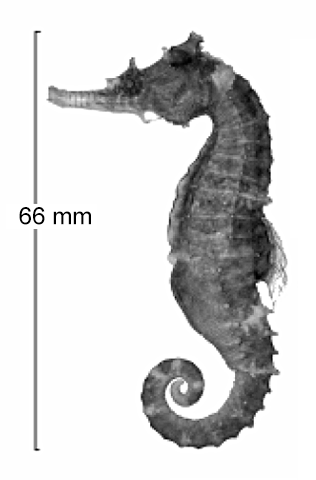| Syngnathidae (Pipefishes and seahorses), subfamily: Hippocampinae |
| 10.4 cm OT (female) |
|
demersal; depth range 16 - 25 m, non-migratory |
| Western Central Pacific: Queensland, Australia. International trade is monitored through a licensing system (CITES II, since 5.15.04) and a minimum size of 10 cm applies. |
|
Dorsal spines (total): 0-0; Dorsal soft rays (total): 17-18. Trunk rings 11; tail rings 34; subdorsal spines 3/0,1,0; nose spine of moderate length, angular in shape; spine above eye long, but shorter than eye diameter; spine behind eye of moderate size, followed by longer lateral head spine; coronet moderately high, sloping back in line with head profile; superior trunk ridge spines reduced to tubercles before dorsal fin in males, or entire ridge having irregular rugose parts with small spines on and in between junctions with rings (Ref. 42735). |
| Occurs over soft bottom of the continental shelf (Ref. 75154). Maximum length is based on a straight-line length measurement from upper surface (ignoring spines) of first trunk ring, to tip of tail (Ref. 42735). Ovoviviparous (Ref. 205). The male carries the eggs in a brood pouch which is found under the tail (Ref. 205). Minimum depth from Ref. 58018. |
|
Not Evaluated
(Ref. 96402)
|
| harmless |
|
Source and more info: www.fishbase.org. For personal, classroom, and other internal use only. Not for publication.
Page created by Jen, 05.08.02,
php script by kbanasihan 06/09/2010 ,
last modified by
dsantos, 20/08/10

